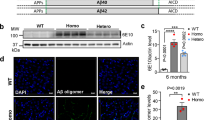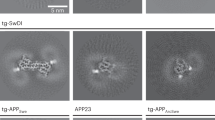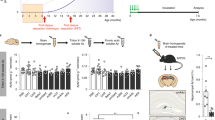Abstract
The Arctic mutation within the amyloid-β (Aβ) peptide causes Alzheimer disease. In vitro, Arctic-mutant Aβ forms (proto)fibrils more effectively than wild-type Aβ. We generated transgenic mouse lines expressing Arctic-mutant human amyloid precursor proteins (hAPP). Amyloid plaques formed faster and were more extensive in Arctic mice than in hAPP mice expressing wild-type Aβ, even though Arctic mice had lower Aβ1-42/1-40 ratios. Thus, the Arctic mutation is highly amyloidogenic in vivo.
This is a preview of subscription content, access via your institution
Access options
Subscribe to this journal
Receive 12 print issues and online access
$209.00 per year
only $17.42 per issue
Buy this article
- Purchase on Springer Link
- Instant access to full article PDF
Prices may be subject to local taxes which are calculated during checkout


Similar content being viewed by others
References
Selkoe, D.J. & Schenk, D. Annu. Rev. Pharmacol. Toxicol. 43, 545–584 (2003).
Caughey, B. & Lansbury, P.T., Jr. Annu. Rev. Neurosci. 26, 267–298 (2003).
Nilsberth, C. et al. Nat. Neurosci. 4, 887–893 (2001).
Dahlgren, K.N. et al. J. Biol. Chem. 277, 32046–32053 (2002).
Murakami, K. et al. J. Biol. Chem. 278, 46179–46187 (2003).
Mucke, L. et al. J. Neurosci. 20, 4050–4058 (2000).
Palop, J.J. et al. Proc. Natl. Acad. Sci. USA 100, 9572–9577 (2003).
Stenh, C. et al. Neuroreport 13, 1857–1860 (2002).
DeMattos, R. et al. Proc. Natl. Acad. Sci. USA 99, 10843–10848 (2002).
Tsubuki, S., Takaki, Y. & Saido, T.C. Lancet 361, 1957–1958 (2003).
Morelli, L. et al. J. Biol. Chem. 278, 23221–22326 (2003).
Herzig, M.C. et al. Nat. Neurosci. 7, 954–960 (2004).
Games, D. et al. Nature 373, 523–527 (1995).
Sisodia, S.S., Koo, E.H., Hoffman, P.N., Perry, G. & Price, D.L. J. Neurosci. 13, 3136–3142 (1993).
Austen, B.M., Frears, E.R. & Davies, H. J. Pept. Sci. 6, 459–469 (2000).
Acknowledgements
We thank E. Koo for the CT15 antibody, P. Seubert for the 8E5 antibody, G.-Q. Yu and X. Wang for technical support, G. Howard and S. Ordway for editorial review, and D. McPherson and L. Manuntag for administrative assistance. This study was supported in part by United States Public Health Services grants AG11385, AG022074 and NS41787 to L.M. and National Institute on Aging-funded Training Grant T32 AG00278 (I.C.).
Author information
Authors and Affiliations
Corresponding author
Ethics declarations
Competing interests
The authors declare no competing financial interests.
Supplementary information
Supplementary Fig. 1
Anti-Aβ antibodies 266 and 3D6 (used in Aβ ELISAs and western blotting) reacted similarly with synthetic Aβ-WT and Aβ-ARC peptides. (PDF 374 kb)
Rights and permissions
About this article
Cite this article
Cheng, I., Palop, J., Esposito, L. et al. Aggressive amyloidosis in mice expressing human amyloid peptides with the Arctic mutation. Nat Med 10, 1190–1192 (2004). https://doi.org/10.1038/nm1123
Received:
Accepted:
Published:
Issue Date:
DOI: https://doi.org/10.1038/nm1123
This article is cited by
-
Critical thinking of Alzheimer’s transgenic mouse model: current research and future perspective
Science China Life Sciences (2023)
-
C5aR1 antagonism alters microglial polarization and mitigates disease progression in a mouse model of Alzheimer’s disease
Acta Neuropathologica Communications (2022)
-
Behavioral and neural network abnormalities in human APP transgenic mice resemble those of App knock-in mice and are modulated by familial Alzheimer’s disease mutations but not by inhibition of BACE1
Molecular Neurodegeneration (2020)
-
Cell-specific deletion of C1qa identifies microglia as the dominant source of C1q in mouse brain
Journal of Neuroinflammation (2017)
-
Influence of mismatched and bulged nucleotides on SNP-preferential RNase H cleavage of RNA-antisense gapmer heteroduplexes
Scientific Reports (2017)



